Cardiology: Difference between revisions
jhgjhsgjhgjhgfjdahfdas;knldfknknlfknsdf |
m Reverted edits by 68.190.17.113 (talk): unexplained content removal (HG) |
||
| Line 56: | Line 56: | ||
[[File:Coronary arteries.png|thumb|350px|Coronary arteries labeled in red text and other landmarks in blue text.]] |
[[File:Coronary arteries.png|thumb|350px|Coronary arteries labeled in red text and other landmarks in blue text.]] |
||
Contrary to a basic understanding of the cardiovascular system, the heart cannot itself receive enough oxygen and nutrients from the blood it pumps and it must be supplied with blood as if it were any other [[organ (anatomy)|organ]] in the body. Unlike the systemic organs the heart receives perfusion in the phase of |
Contrary to a basic understanding of the cardiovascular system, the heart cannot itself receive enough oxygen and nutrients from the blood it pumps and it must be supplied with blood as if it were any other [[organ (anatomy)|organ]] in the body. Unlike the systemic organs the heart receives perfusion in the phase of diastole rather than systole. This circulation of blood is called the [[coronary circulation]]. |
||
The coronary circulation consists of [[coronary artery|coronary arteries]] and [[coronary vein]]s. |
|||
Disorders of the coronary circulation can have devastating effects to the heart since damage to the heart can reduce coronary circulation which causes further damage. A few examples are presented, as follows: |
|||
; [[Acute coronary syndrome]] (ACS) : Acute coronary syndrome is a broad term encompassing many acute [[myocardial infarction]] symptoms. |
|||
; [[Angina pectoris]]: Angina pectoris literally means "chest pain" that refers to pain caused by [[ischemia]] of the heart. |
|||
; [[Atherosclerosis]]: Atherosclerosis is the condition in which an artery wall thickens as the result of a build-up of fatty materials (e.g., [[cholesterol]]). Atherosclerosis of a coronary artery leads to [[coronary heart disease]]. |
|||
; [[Coronary heart disease]]: Coronary heart disease is a general term for any reduction in coronary circulation. One such condition is [[atherosclerosis]]. |
|||
; [[Myocardial infarction]] (aka heart attack) : A myocardial infarction is the death of a part of the heart which is typically caused by a blockage of the coronary circulation or [[coronary heart disease]]. |
|||
; [[Restenosis]]: Recurrence of [[stenosis]] which would refer to a narrowing of a [[coronary artery]] in the context of the coronary circulation. |
|||
=== Cardiac arrest === |
=== Cardiac arrest === |
||
[[File:Asystole11.JPG|thumb|350px|A rhythm strip showing a couple beats of normal sinus rhythm followed by an atrial beat and [[asystole]] ("flatline").]] |
[[File:Asystole11.JPG|thumb|350px|A rhythm strip showing a couple beats of normal sinus rhythm followed by an atrial beat and [[asystole]] ("flatline").]] |
||
Revision as of 18:21, 19 August 2014
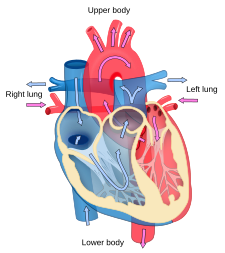 Blood flow diagram of the human heart. Blue components indicate de-oxygenated blood pathways and red components indicate oxygenated pathways. | |
| System | Cardiovascular |
|---|---|
| Subdivisions | Interventional, Nuclear |
| Significant diseases | Heart disease, Cardiovascular disease, Atherosclerosis, Cardiomyopathy, Hypertension (High Blood Pressure) |
| Significant tests | Blood tests, Electrophysiology study, Cardiac imaging, ECG, Echocardiograms, Stress test |
| Specialist | Cardiologist |
Cardiology (from Greek καρδίᾱ kardiā, "heart" and -λογία -logia, "study") is a medical specialty dealing with disorders of the heart be it human or animal. The field includes medical diagnosis and treatment of congenital heart defects, coronary artery disease, heart failure, valvular heart disease and electrophysiology. Physicians who specialize in this field of medicine are called cardiologists. Physicians who specialize in cardiac surgery are called cardiac surgeons.
Specialization
Cardiology is a specialty of internal medicine. To be a cardiologist in the United States, a three year residency in internal medicine is followed by a three year residency in cardiology. It is possible to specialize further in a sub-specialty. Recognized sub-specialties in the United States by the ACGME are:[citation needed]
- Cardiac electrophysiology : Study of the electrical properties and conduction diseases of the heart.
- Echocardiography : The use of ultrasound to study the mechanical function/physics of the heart.
- Interventional cardiology : The use of catheters for the treatment of structural and ischemic diseases of the heart.
- Nuclear cardiology : The use of nuclear medicine to visualize the uptake of an isotope by the heart using radioactive sources.
Recognized subspecialties in the United States by the American Osteopathic Association Bureau of Osteopathic Specialists (AOABOS) include:[1]
- Clinical cardiac electrophysiology
- Interventional cardiology
The heart
As the center focus of cardiology, the heart has numerous anatomical features (e.g., atria, ventricles, heart valves) and numerous physiological features (e.g., systole, heart sounds, afterload) that have been encyclopedically documented for many centuries.
Disorders of the heart lead to heart disease and cardiovascular disease and can lead to a significant number of deaths: cardiovascular disease is the leading cause of death and caused 29.34% of all deaths in 2002.[citation needed]
The primary responsibility of the heart is to pump blood throughout the body. It pumps blood from the body — called the systemic circulation — through the lungs — called the pulmonary circulation — and then back out to the body. This means that the heart is connected to and affects the entirety of the body. Simplified, the heart is a circuit of the Circulation. While plenty is known about the healthy heart, the bulk of study in cardiology is in disorders of the heart and restoration, and where possible, of function.
The heart is a muscle that squeezes blood and functions like a pump. Each part of the heart is susceptible to failure or dysfunction and the heart can be divided into the mechanical and the electrical parts.
The electrical part of the heart is centered on the periodic contraction (squeezing) of the muscle cells that is caused by the cardiac pacemaker located in the sinoatrial node. The study of the electrical aspects is a sub-field of electrophysiology called cardiac electrophysiology and is epitomized with the electrocardiogram (ECG/EKG). The action potentials generated in the pacemaker propagate throughout the heart in a specific pattern. The system that carries this potential is called the electrical conduction system. Dysfunction of the electrical system manifests in many ways and may include Wolff–Parkinson–White syndrome, ventricular fibrillation, and heart block.
The mechanical part of the heart is centered on the fluidic movement of blood and the functionality of the heart as a pump. The mechanical part is ultimately the purpose of the heart and many of the disorders of the heart disrupt the ability to move blood. Failure to move sufficient blood can result in failure in other organs and may result in death if severe. Heart failure is one condition in which the mechanical properties of the heart have failed or are failing, which means insufficient blood is being circulated.
Disorders
Cardiology is concerned with the normal functionality of the heart and the deviation from a healthy heart. Many disorders involve the heart itself but some are outside of the heart.
Disorders of the coronary circulation
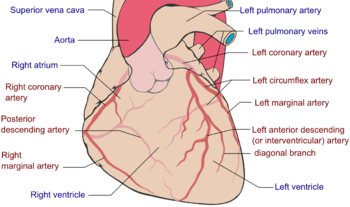
Contrary to a basic understanding of the cardiovascular system, the heart cannot itself receive enough oxygen and nutrients from the blood it pumps and it must be supplied with blood as if it were any other organ in the body. Unlike the systemic organs the heart receives perfusion in the phase of diastole rather than systole. This circulation of blood is called the coronary circulation. The coronary circulation consists of coronary arteries and coronary veins.
Disorders of the coronary circulation can have devastating effects to the heart since damage to the heart can reduce coronary circulation which causes further damage. A few examples are presented, as follows:
- Acute coronary syndrome (ACS)
- Acute coronary syndrome is a broad term encompassing many acute myocardial infarction symptoms.
- Angina pectoris
- Angina pectoris literally means "chest pain" that refers to pain caused by ischemia of the heart.
- Atherosclerosis
- Atherosclerosis is the condition in which an artery wall thickens as the result of a build-up of fatty materials (e.g., cholesterol). Atherosclerosis of a coronary artery leads to coronary heart disease.
- Coronary heart disease
- Coronary heart disease is a general term for any reduction in coronary circulation. One such condition is atherosclerosis.
- Myocardial infarction (aka heart attack)
- A myocardial infarction is the death of a part of the heart which is typically caused by a blockage of the coronary circulation or coronary heart disease.
- Restenosis
- Recurrence of stenosis which would refer to a narrowing of a coronary artery in the context of the coronary circulation.
Cardiac arrest

Cardiac arrest refers to the cessation(to cease)of normal systemic circulation due to failure in proper contraction of the heart. There are several conditions that can cause cardiac arrest.
- Asystole ("flatline")
- Asystole refers to the absence of electrical activity of the heart and is sometimes referred to as a "flatline" because the electrocardiogram shows a solid line due to the absence of electrical activity.
- Pulseless electrical activity (PEA)
- Pulseless electrical activity is when the electrocardiogram shows a rhythm that should produce a pulse but it does not. PEA is commonly caused by the 6 H's and 6 T's (see PEA article).
- Pulseless ventricular tachycardia
- Pulseless ventricular tachycardia (VT) Is one classification of VT such that no pulse is felt because of an ineffective cardiac output which causes cardiac arrest.
- Sudden cardiac death
- Sudden cardiac death is a concept of natural death rather than a specific medical condition. There are several causes of sudden cardiac death and it is distinct from cardiac arrest.
- Ventricular fibrillation
- Ventricular fibrillation is fibrillation of the ventricles of the heart. Rhythmic contraction is necessary for efficient movement of blood and fibrillation disrupts this rhythm sufficiently to cause cardiac arrest
Treatment of cardiac arrest includes cardiopulmonary resuscitation (CPR) and defibrillation depending on the exact cause of cardiac arrest.
Disorders of the myocardium (muscle of the heart)

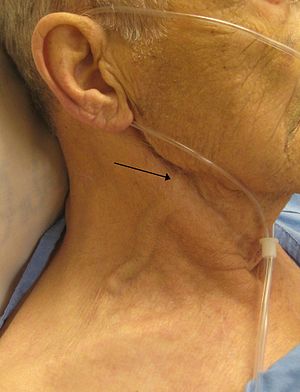
- Cardiomyopathy
- Cardiomyopathy is a deterioration of the myocardium.
- Ischemic cardiomyopathy
- Cardiomyopathy causing ischemia of the heart due to coronary artery disease.
- Nonischemic cardiomyopathy
- Cardiomyopathy not caused by ischemia of the heart.
- Amyloid cardiomyopathy
- Cardiomyopathy caused by amyloidosis.
- Hypertrophic cardiomyopathy (HCM)
- Cardiomyopathy caused by hypertrophy of the heart.
- Hypertrophic obstructive cardiomyopathy (HOCM) (Idiopathic hypertrophic subaortic stenosis (IHSS))
- Dilated cardiomyopathy
- Cardiomyopathy caused by dilation of the heart.
- Alcoholic cardiomyopathy
- A type of dilated cardiomyopathy caused by chronic abuse of alcohol.
- Tachycardia induced cardiomyopathy
- A type of dilated cardiomyopathy caused by chronic tachycardia.
- Takotsubo cardiomyopathy (Transient apical ballooning, stress-induced cardiomyopathy)
- A type of dilated cardiomyopathy caused by a sudden temporary weakening of the myocardium.
- Arrhythmogenic right ventricular dysplasia (Arrhythmogenic right ventricular cardiomyopathy)
- Cardiomyopathy caused by a genetic mutation of the desmosomes that connect myocytes.
- Restrictive cardiomyopathy
- Cardiomyopathy caused by excessive rigidity of the heart.
- Heart failure
- Failure of the heart to produce sufficient blood flow to meet metabolic demands of the body.
- Cor pulmonale
- Untreated cor pulmonale can cause right heart failure from chronic pulmonary hypertrophy.
- Primary tumors of the heart
- Tumors that arise initially in the heart and not from elsewhere in the body.
- Myxoma
- Most common tumor of the heart.
- Myocardial rupture
- A gross structural failure of the heart. Commonly a result of myocardial infarction.
Disorders of the pericardium (outer lining of the heart)

The pericardium is a double-walled sac — fibrous pericardium and serous pericardium — that contains the heart.
- Constrictive pericarditis
- Pericarditis that constricts the expansion of the heart and inhibits heart function.
- Pericardial effusion
- An abnormal accumulation of fluid in the pericardium that can lead to tamponade.
- Pericardial tamponade
- Accumulation of fluid in the pericardium that inhibits heart function.
- Pericarditis
- Inflammation of the pericardium.
Disorders of the heart valves
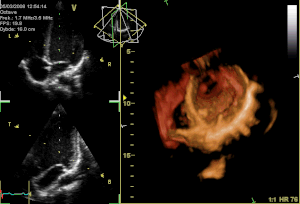
The heart contains four valves that direct the flow of blood in a single direction. Failure to prevent reverse-flow is called regurgitation, or insufficiency. Narrowing of the valves obstructs flow and is called stenosis.
- Aortic valve
- Disorders and treatments of the aortic valve that separates the left ventricle and aorta.
- Aortic regurgitation / aortic insufficiency
- Deficiency of the aortic valve that permits regurgitation from the aorta into the left ventricle.
- Aortic stenosis
- Narrowing of the aortic valve opening that reduces blood flow through the valve.
- Aortic valve replacement
- Replacement of the aortic valve due to aortic regurgitation, aortic stenosis, or other reasons.
- Aortic valve repair
- Repair, instead of replacement, of the aortic valve.
- Aortic valvuloplasty
- Repair of the valve by using a balloon catheter to force it open.
- Mitral valve
- Disorders and treatments of the mitral valve that separates the left atrium and left ventricle.
- Mitral valve prolapse
- Prolapse of the mitral valve into the left atrium during ventricular systole.
- Mitral regurgitation / mitral insufficiency
- Deficiency of the mitral valve that permits regurgitation from the left ventricle into the left atrium.
- Mitral stenosis
- Narrowing of the mitral valve opening that reduces blood flow through the valve.
- Mitral valve replacement
- Replacement of the mitral valve due to mitral regurgitation, mitral stenosis, or other reasons.
- Mitral valve repair
- Repair, instead of replacement, of the mitral valve.
- Mitral valvuloplasty
- Repair of the valve by using a balloon catheter to force it open.
- Pulmonary valve
- Disorders of the pulmonary valve that separates the right ventricle and pulmonary artery.
- Pulmonary regurgitation / pulmonary insufficiency
- Deficiency of the pulmonary valve that permits regurgitation from the pulmonary artery into the right ventricle.
- Pulmonic stenosis
- Narrowing of the pulmonary valve opening that reduces blood flow through the valve.
- Tricuspid valve
- Disorders of the tricuspid valve that separates the right atrium and right ventricle.
- Tricuspid regurgitation / tricuspid insufficiency
- Deficiency of the tricuspid valve that permits regurgitation from the right ventricle into the right atrium.
Congenital heart defect

Congenital heart defects are defects in the structure of the heart which are present at birth.
- Atrial septal defect
- Defect in the interatrial septum that permits blood flow between atria, including a patent foramen ovale (PFO).
- Bicuspid aortic valve
- Formation of two valve leaflets in the aortic valve instead of three leaflets.
- Hypoplastic left heart syndrome
- Defect in the development of the left heart such that it is hypoplastic (under developed).
- Patent ductus arteriosus (PDA)
- Failure of the ductus arteriosus to close on birth.
- Patent foramen ovale (PFO)
- An atrial septal defect in that the foramen ovale fails to close at birth.
- Persistent truncus arteriosus
- Defect in that the truncus arteriosus fails to divide.
- Tetralogy of Fallot
- Set of four anatomical abnormalities: pulmonary stenosis, overriding aorta, ventricular septal defect, and right ventricular hypertrophy.
- Transposition of the great vessels (TGV)
- Abnormal spatial arrangement of the great vessels (superior vena cava, inferior vena cava, pulmonary arteries, pulmonary veins, and aorta).
- Ventricular septal defect
- Defect in the ventricular septum that permits blood flow between ventricles.
Diseases of blood vessels (vascular diseases)

- Atherosclerosis
- Thickening of an arterial wall due to increased cholesterol and macrophages.
- Aneurysm
- Balloon-like bulging of the artery.
- Aorta
- Diseases of the aorta:
- Coarctation of the aorta
- Narrowing of the aorta at the ductus arteriosus/ligamentum arteriosum.
- Aortic dissection
- Dissection along the length of the aorta between the layers of the aortic wall and filled with blood.
- Aortic aneurysm
- Aneurysm of the aorta.
- Carotid artery
- Diseases of the carotid arteries:
- Carotid artery stenosis / carotid artery disease; Narrowing of the carotid artery, typically due to atherosclerosis.
- Carotid artery dissection
- Dissection along the length of the carotid artery between the layers of the carotid wall and filled with blood.
- Deep vein thrombosis (DVT)
- Formation of a thrombus in a deep vein, commonly in the legs.
- Traveller's thrombosis / economy class syndrome
- A DVT due to being sedentary during air travel.
- Varicose veins
- Veins that have become enlarged and tortuous with failed valves, commonly in the legs.
- Vasculitis
- Inflammation of blood vessels.
Procedures to counter coronary artery disease

- Coronary artery bypass surgery (CABG)
- Grafting an artery or vein from elsewhere (typically the leg) to bypass a stenotic coronary artery.
- Enhanced external counterpulsation (EECP)
- Pneumatically assisting the heart to move blood using inflatable cuffs on the legs.
- Percutaneous coronary intervention (PCI)
- Procedures to treat stenotic coronary arteries by accessing through a blood vessel.
- Percutaneous Transluminal Coronary Angioplasty (PTCA)
- Enlarging the lumen of a coronary artery by forcibly expanding it with a balloon.
- Atherectomy
- Enlarging the lumen of a coronary artery by removal of atherosclerotic plaque.
- Stenting
- Enlarging the lumen of a coronary artery by forcibly expanding it with a metal wire tube.
Devices used in cardiology

- Stethoscope
- Acoustic device for hearing internal sounds including heart sounds.
- Devices used to maintain normal electrical rhythm
-
- Pacemaker
- An implanted electrical device that replaces the heart's natural pacemaker.
- Defibrillator
- Electrical devices to alter the heart's rhythm with electrical energy.
- Automated external defibrillator (AED)
- An external defibrillator that is commonly found outside of health care settings. Often designed for anyone to use.
- Implantable cardioverter-defibrillator (ICD)
- An implanted device to prevent life-threatening conditions (e.g., ventricular tachycardia, ventricular fibrillation).
- Devices used to maintain blood pressure
-
- Artificial heart
- An internal pump that wholly replaces the pumping action of the heart.
- Cardiopulmonary bypass (CPB) / heart-lung machine
- External pump to take over the function of both the heart and lungs.
- Intra-aortic balloon pump (IABP)
- A balloon placed in the thoracic aorta to supplement cardiac output from the heart.
- Ventricular assist device
- Internal pump to supplement or replace the pumping action of a ventricle.
Diagnostic tests and procedures
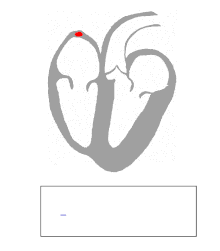
Various cardiology diagnostic tests and procedures.
- Blood tests
- Echocardiography ("echo")
- Ultrasonography of the heart to inspect chambers, valves, and blood flow.
- Transthoracic echocardiogram (TTE)
- Echocardiogram of the heart through the thorax external to the body.
- Transesophageal echocardiogram (TEE)
- Echocardiogram of the heart through a catheter placed in the esophagus.
- Cardiovascular magnetic resonance imaging (CMR)
- Magnetic resonance imaging (MRI) of the heart that utilizes the ECG for gating and to look at specific mechanical functions of the heart.
- Cardiac stress test
- Testing of the cardiovascular system through controlled exercise or drugs.
- Auscultation
- Listening to sounds (e.g., heart sounds) with a stethoscope.
- Electrocardiography (ECG or EKG)
- Measurement of the electrical activity of the heart, typically with 4 or 10 electrodes on the skin.
- Holter monitor
- Portable ECG device for continuous monitoring.
- Electrophysiology study
- Studying the electrical activity of the heart through the use of catheters placed in the heart via veins or arteries.
- Sphygmomanometer
- Blood pressure cuff used to measure arterial blood pressure.
- Cardiac marker
- Testing for biomarkers in the blood that may indicate various conditions.
- Coronary catheterization
- Catheterization of the coronary arteries.
- Fractional flow reserve (FFRmyo)
- Testing the blood flow through a stenosis of a coronary artery to determine the perfusion of the heart.
- Intravascular ultrasound (IVUS)
- Ultrasonography of a coronary artery.
- Optical coherence tomography (OCT)
- Testing through the use of optical scattering for coronary artery disease.
Cardiologists
| Occupation | |
|---|---|
| Names | Doctor, Medical Specialist |
Occupation type | Specialty |
Activity sectors | Medicine |
| Description | |
Education required |
|
Fields of employment | Hospitals, Clinics |
- Robert Atkins (1930–2003), known for the Atkins diet
- Eugene Braunwald (born 1929), editor of Braunwald's Heart Disease and 1000+ publications
- Willem Einthoven (1860–1927), a physiologist who built the first practical ECG and won the 1924 Nobel prize in medicine
- Andreas Gruentzig (1939–1985), first developed balloon angioplasty
- Max Holzmann (1899-1994), co-founder of the Swiss Society of Cardiology, president from 1952–1955
- Samuel A. Levine (1891–1966), recognized the sign known as Levine's sign as well as the current grading of the intensity of heart murmurs, known as the Levine scale
- Henry Marriott (1917–2007), ECG interpretation and Marriott's Practical Electrocardiography
- John Parkinson (1885–1976), known for Wolff–Parkinson–White syndrome
- Helen B. Taussig (1898–1986), founder of pediatric cardiology and extensively worked on blue baby syndrome
- Paul Dudley White (1886–1973), known for Wolff–Parkinson–White syndrome
- Louis Wolff (1898–1972), known for Wolff–Parkinson–White syndrome
- Bernard Lown (born 1921) known for being the original developer of the Defibrillator
Journals
- Acta Cardiologica
- American Journal of Cardiology
- Annals of Cardiac Anaesthesia
- Cardiology
- Cardiology in Review
- Circulation
- Circulation Research
- Clinical and Experimental Hypertension
- Clinical Cardiology
- EP – Europace
- European Heart Journal
- Heart
- Heart Rhythm
- International Journal of Cardiology
- Journal of the American College of Cardiology
- Pacing and Clinical Electrophysiology
Associations
- American College of Cardiology
- American Heart Association
- Heart Rhythm Society
- National Heart Foundation of Australia
See also
References
- ^ "Specialties & Subspecialties". American Osteopathic Association. Retrieved 23 September 2012.
